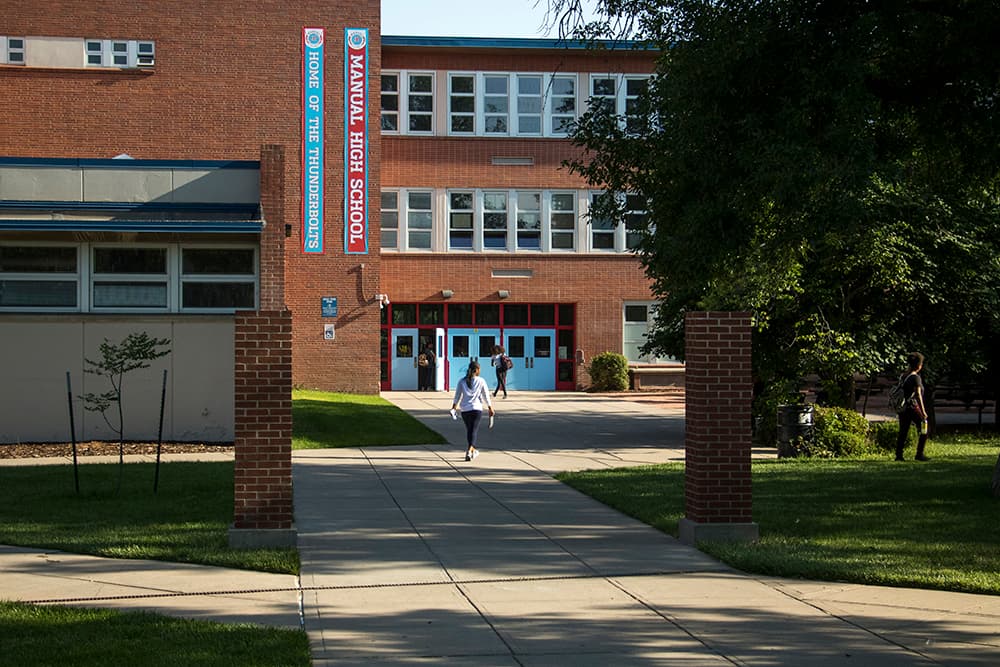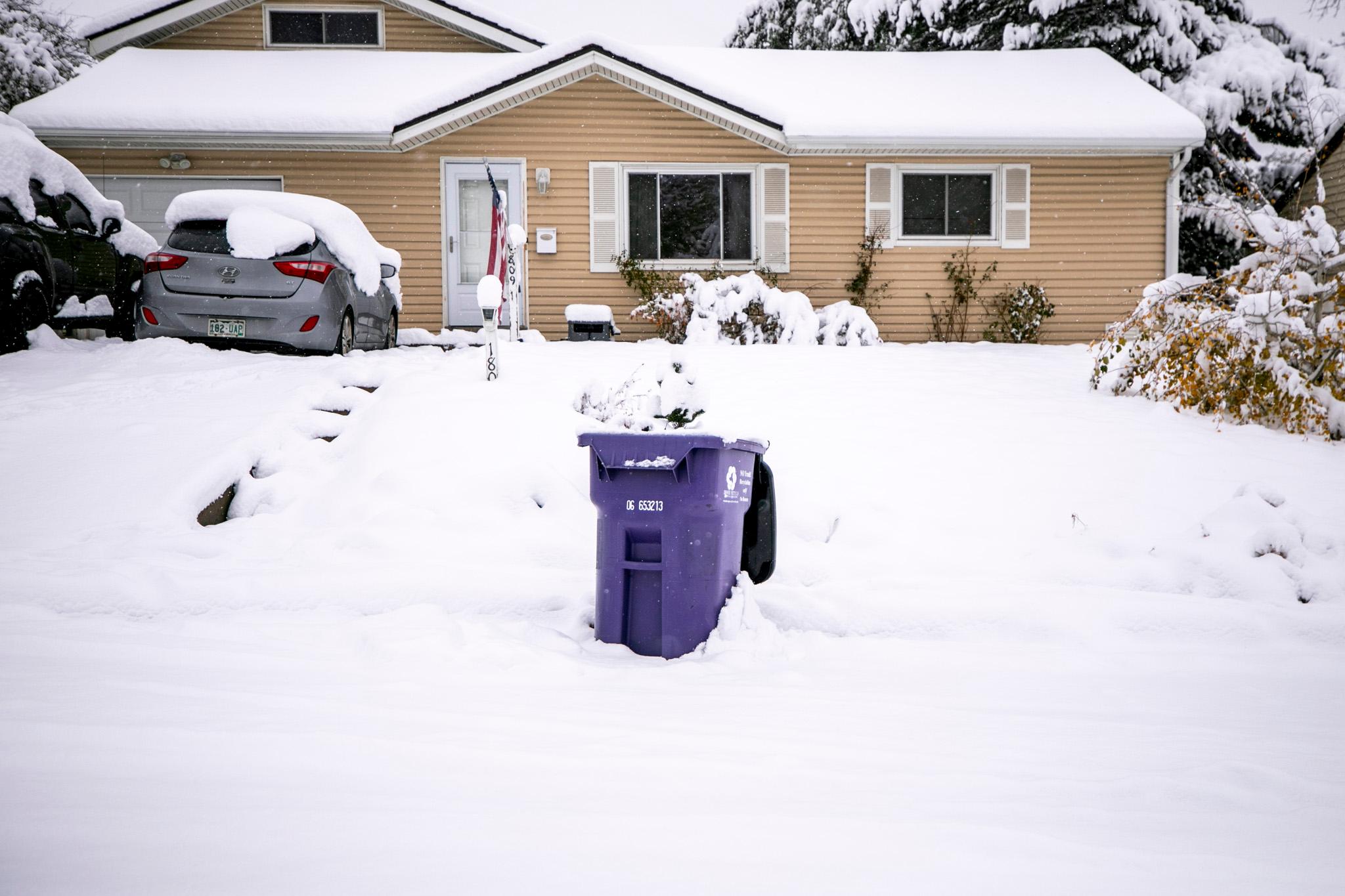Denver’s storied but academically struggling Manual High School faces the possibility of state intervention next school year after earning five consecutive low ratings from the Colorado Department of Education. It is the only one of Denver’s more than 200 schools facing that risk.
Manual’s situation is noteworthy because Denver Public Schools generally has taken aggressive action toward low-performing schools before the law allows the state to step in. The district hasn’t shied away from replacing or closing struggling schools, which has earned it criticism from those who think the tactics are too harsh.
In fact, the district closed and reopened Manual more than a decade ago because of lagging test scores and declining enrollment. The controversial decision still evokes painful memories in the community. Since then, the school has cycled through leaders and repeated overhauls of its academic program.
Manual is not the first Denver school to earn five low ratings, which are based largely on annual test scores. But the other schools were either closed by the district or able to turn around their performance to avoid sanctions. District officials are confident Manual will turn it around, too.
The school has one more chance. If it earns a higher rating next year, the state will put on hold the threat of intervention, which could include conversion to a charter school or even closure. Two years of higher ratings would put Manual in the clear.
But the northeast Denver high school faces hurdles on its road to improvement, including that it doesn’t have a permanent leader. Its last principal – a charismatic Denver native and the architect of the school’s latest rebirth – resigned suddenly in March. An investigation found Nick Dawkins violated the district’s policy against harassment, discrimination, and retaliation.
The school has an interim principal and is searching for a permanent one. A search in the spring netted three candidates, but the top prospect turned down the job.
“Our focus is on making sure Manual is a great school for its students,” Superintendent Tom Boasberg said. “We’re excited and confident about Manual moving forward.”
Manual is one of the district’s oldest high schools, and its alumni include several prominent Denverites, including the city’s current mayor. Last year, it served just over 300 students, 90 percent of whom were from low-income families and 96 percent of whom were students of color.
In preliminary school ratings recently released by the Colorado Department of Education, Manual earned the second-lowest: “priority improvement,” which is coded with the color orange. The ratings are based on state tests students took in the spring.
Alumna Lainie Hodges said she’s not surprised Manual did poorly by that measure. The students went through what she called “a year of constant trauma” that started with the deaths of a fellow student and a recent graduate, and continued with a headline-grabbing controversy over whether fans of an opposing high school football team had displayed a Confederate flag during a game against Manual.
Then, a month before students were scheduled to take the state-required PSAT and SAT tests, Manual’s popular principal resigned.
“That they didn’t show up and test well, I’m not surprised at all,” said Hodges, who graduated from Manual in 1997 and until earlier this year was the board chair of the Friends of Manual High School booster group. “Is it a measure of their talent and ability? Absolutely not.”
Recent graduate Elijah Beauford said he’s not surprised by the test scores, either. He said he himself struggled with tests as a student. But he excelled at the work he did in class and at home, encouraged by teachers with whom he said he had a “genuine connection.”
Many of those teachers were people of color, as was Dawkins, the former principal. Beauford, who transferred to Manual in his junior year from a school in Aurora, said he hadn’t ever attended a school where most of the staff, and the students sitting in the honors classes, looked like him.
“Seeing people who look like me in high-ranking positions of power, it’s subconsciously and consciously empowering,” said Beauford, who graduated in 2017.
That environment helped Beauford thrive. His confidence grew, his GPA shot up, and he went from a student who struggled with reading to one who consistently won first prize at high school speech competitions around the city. Beauford, who goes by the name Young Activist, has continued to give speeches and become involved with local education advocacy groups.
“I personally believe that the school doesn’t make the students, the students make the school,” Beauford said. People say Manual has a bad reputation, he said, but the reality is that “there’s a lot of good kids there who are in bad situations but still coming to school each and every day.”
There are two big caveats to Manual’s low state rating. The first is that districts can appeal the ratings of individual schools. State officials have until December to decide.
The second caveat is that Manual’s quandary is partly Denver Public Schools’ own making. The district has its own school rating system that it considers more rigorous. In cases where Denver rates a school lower than the state, the district asks the state to use the district’s rating instead. In three of the past five years, the state lowered Manual’s rating at the district’s request.
Crucially, in 2017, the district asked the state to lower Manual’s rating from yellow to orange. Yellow would have gotten Manual off the state “accountability clock.” (The clock refers to the amount of time low-performing schools and districts have to improve before the State Board of Education can order them take action.) But an orange rating kept it on.
There was also a year when Denver rated Manual higher than the state – and the state refused to raise its rating. That also had the effect of keeping Manual on the clock.
In an interview, Boasberg was quick to point out that Manual wouldn’t be on the clock had the district not requested the state lower Manual’s ratings. However, he was also gracious about the state’s role in ensuring all Colorado schools are meeting certain standards.
“We and (the Colorado Department of Education) have exactly the same objective, which is to ensure every student at Manual gets a great education,” Boasberg said. “We have collaborated, and we continue to collaborate, closely with CDE.”
Boasberg said his confidence about Manual’s future stems from its recently revised “innovation plan,” which describes the steps the school will take to boost student performance. Manual was one of Colorado’s first “innovation schools,” which means it has permission to waive certain state and district rules, as well as parts of the teachers union contract. The idea behind innovation schools is that increased flexibility will lead to better student outcomes.
Manual’s plan, which was submitted by Dawkins, includes more time for teacher training and more opportunities for students to take college-level courses. Manual is one of 20 state-designated “early college high schools,” meaning students can earn an associate degree or up to 60 college credits by the time they graduate high school.
But a new state law aimed at reining in the cost of early colleges limits the time students can take to complete their associate degree or earn their 60 credits. As a result, Denver Public Schools is redesigning its six early college high schools, including Manual.
Manual also has a unique career education program called the Med School at Manual geared toward students interested in careers in health care. The program offers classes in topics such as human anatomy and sports medicine, as well as job shadows, field trips, and internships.
Denver Public Schools has pumped an additional $3 million into Manual since 2015 in an attempt to help improve the school’s performance. The district refers to that money as “tiered support funding,” and Manual received it because of its low school ratings.
If the school’s state rating holds steady at orange this year, and it doesn’t improve next year, its leaders will find themselves before the State Board of Education in the spring of 2020.
Hodges said she hopes state officials, when deciding which action to take, consider Manual’s rich history, its recent trauma, and district decisions that she thinks hurt the school. She said she hopes state officials see Manual as worth fighting for.
“Because we do,” she said.
Chalkbeat is a nonprofit news site covering educational change in public schools.














